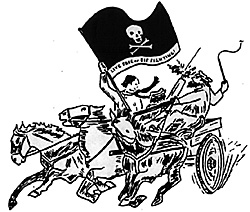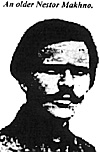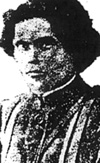 Tatchanka - Ukraine, 1919-1921 is a strategic simulation of one of
the last parts of the Russian Civil War, the three-year struggle in the Ukraine after
World War I. It was designed in 1977 by Jim Bumpas.
Tatchanka - Ukraine, 1919-1921 is a strategic simulation of one of
the last parts of the Russian Civil War, the three-year struggle in the Ukraine after
World War I. It was designed in 1977 by Jim Bumpas.
Background
[The following passage represents the Historical Notes which came with the game.]
The Russian Civil War was a confusing and chaotic time in Russian history. In the Ukraine, confusion and chaos were even more pronounced than in other areas of Russia. It wasn't just that individual loyalties were fluid during much of the period between 1919 and 1921.
Whole armies and "governments" switched sides. In some history books you will read, for instance, that Red armies marched victoriously into Odessa in the spring of 1919. Yet just a few months later, the Red armies were in retreat with White armies in Orel, only a few miles from Moscow. It happened almost faster than an army can move from Odessa to Orel. How did it happen?
Well, for one thing, the "red" army which took Odessa abandoned the Bolshevik cause for the Ukrainian nationalist cause. When that happened, there was essentially no Red army in the Ukraine excepts for bands of Makhnovists which were still allied to the Bolsheviks at the time.
Tatchanka attempts to simulate the sweeping dynamism of a campaign across the steppes. The treatment of terrain is fluid, and the treatment of forces is just as fluid. You might find former Red units included in the forces of any other side. White units may have defected several times into different armies: a white unit may have defected to the Makhnovists, then to the Ukrainians, and then to the Reds. It did happen.
Defections were such a problem that the Bolsheviks devoted quite a lot of energy to developing their Cheka battalions. These would comb the rear area looking for disarmed soldiers to send back to their units. If revolutionary zeal was insufficient, then the barrel of a gun was used to force stragglers back into their units.
 The Makhnovists never took prisoners.
They would kill all officers (unless an
enlisted man would speak for them) and
offer the other ranks a choice: either join
the Revolutionary Insurrectionary Army of
the Makhnovists; or promise to go back
home and stop fighting against them. Many
were faced with this choice twice, after
being rounded up by the Cheka.
The Makhnovists never took prisoners.
They would kill all officers (unless an
enlisted man would speak for them) and
offer the other ranks a choice: either join
the Revolutionary Insurrectionary Army of
the Makhnovists; or promise to go back
home and stop fighting against them. Many
were faced with this choice twice, after
being rounded up by the Cheka.
The very name of this game underscores the fluidity of the campaign. The main tactical instrument which allowed the Makhnovists to range so widely in their maneuvers was the tatchanka. A peasant cart, pulled by three horses, and mounting a.50 cal. water-cooled machine gun to the rear, helped to discourage pursuit.
 The whole peasant army of Nestor Makhno (at right, younger days)
was thus mobilized. Infantry and the tail of
the army rode in these wagons. The rest
of the army was mounted on horseback.
The whole peasant army of Nestor Makhno (at right, younger days)
was thus mobilized. Infantry and the tail of
the army rode in these wagons. The rest
of the army was mounted on horseback.
This was a very enjoyable game to playtest. A successful offensive can build momentum and sweep all before it. After several combats your army may well be stronger than when you began. Nothing stops you until you get too overconfident and stumble at a hard place. Then you have to look for a place to hide while you build your forces again. You will be fortunate if your opponent gives you time to rest.
Aside from the standard histories which you may find in any library, I used the following, less available sources:
- The Unknown Revolution, 1917-
1921, by Voline, Black & Red, Detroit,
1974; and
The History of the Makhnovist Movement in the Ukraine, 1919-1921 by Peter Arshinov, Black & Red, Detroit, 1974.
Tatchanka: Ukraine 1919-1921
- Tatchanka: Background
Tatchanka: Game Review
Tatchanka: Component Manifest
Tatchanka: Collector's Value
Back to Simulacrum Vol. 1 No. 1 Table of Contents
Back to Simulacrum List of Issues
Back to MagWeb Master Magazine List
© Copyright 1999 by Steambubble Graphics
This article appears in MagWeb (Magazine Web) on the Internet World Wide Web. Other military history articles and gaming articles are available at http://www.magweb.com